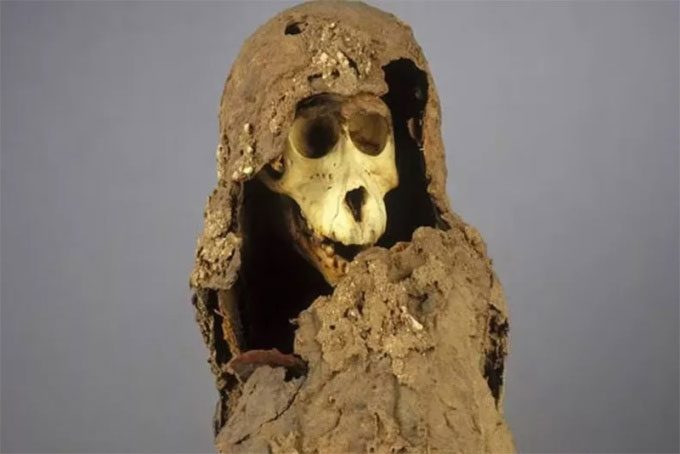Over 2,500-Year-Old Mummified Baboon Remains Discovered in the Monkey Valley, Far from Their Native Home, Leaving Experts Puzzled.
In 1905, mummified baboons were discovered in Egypt, prompting scientists to grapple with why they were found so far from their homeland. Now, after more than 100 years, experts have combined biology and history to unravel this mystery, as reported by IFL Science on November 10th.

Mummified baboon (specimen 90001206) from Gabbanat el-Qurud, Egypt, preserved by the Musée des Confluences, France. (Photo: Patrick Ageneau).
A new study published in the journal eLife, led by expert Gisela Kopp from the University of Konstanz and her colleagues, also sheds light on historical trade routes and the cultural significance of this primate group in ancient Egypt.
The mummified baboons date back to the late period of ancient Egypt, around 800 – 540 BC. They were found at Gabbanat el-Qurud, or the Monkey Valley, and had missing canines. However, they are not native to Egypt. The hamadryas baboon (Papio hamadryas) hails from the Horn of Africa and the southwestern Arabian Peninsula.
This species was highly revered in ancient Egypt. They were mummified and offered as gifts in honor of the god Thoth—the deity of learning and wisdom, often depicted as a hamadryas baboon. But how these baboons arrived in Egypt has remained a mystery for over a century.
In 2020, researchers traced their origins to the Horn of Africa. Now, Kopp’s team has pinpointed their exact location. They also successfully analyzed ancient DNA from the mummies of non-human primates for the first time.
Kopp’s new genetic analysis method involves studying the mitochondrial genome of the mummies and comparing it with existing baboons. By extracting DNA from a specimen in a museum, Kopp narrowed their homeland down to a specific region around Eritrea—where the renowned port of Adulis likely once existed.
According to ancient records, Adulis was a trading hub for luxury goods and animals. However, this does not explain why baboons were transported from their homeland to Egypt, as the mummies date back long before the development of the Adulis port. Another port, known as Punt, was where Egypt imported goods until the first millennium BC and is often considered the source of the baboons. Yet, the exact location of this port remains a mystery.
“Egyptologists have long pondered the identity of Punt. Some scholars view it as a site within the early global maritime trade network, marking the beginning of economic globalization. The specimen we studied aligns chronologically with the last voyages to Punt. However, geographically, the specimen matches Adulis, known as a site for trading primates centuries later,” Kopp stated.
Thus, Kopp and her colleagues suggest that Punt and Adulis are essentially the same location, differing only in name at different times. “Once we contextualized our biological findings within historical research, the story truly began to connect,” Kopp remarked.


















































